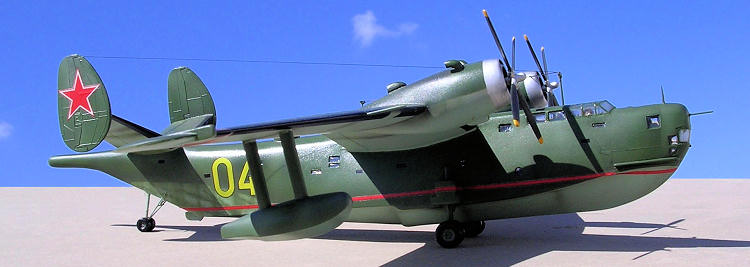
VEB 1/72 Beriev Be-6
| KIT #: | ? |
| PRICE: | $? |
| DECALS: | one option |
| REVIEWER: | Carmel J. Attard |
| NOTES: | injected in white and black plastic, material of components very brittle. Decals supplied. Kit requires a good deal of updating. |

| HISTORY |
The Be-6 is a large maritime reconnaissance and bombing flying boat that
flew for the first time in 1947. It was an all-metal high-wing monoplane that was powered by two 2000hp Shvetsov ASh-72 radial engines. Until early sixties it was still in
service and was relegated to fishing patrol and protection duties with the
Soviet Navy. It is the only Russian flying boat of post war design to have attained quantity production.
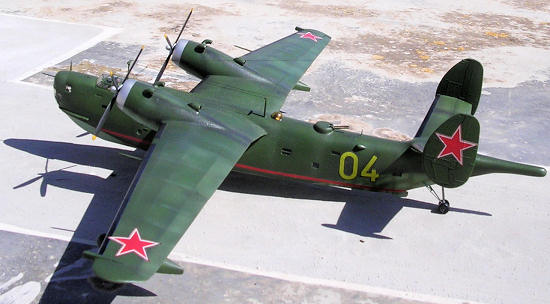 Be-6 are known to have formed part of
the North Fleet since 1953 in both the rescue
form that was based at Poty, and others belonging to the 318th Independent ASW Air Regiment at Donuzlav in 1967. Other Be-6s were based at the hydrobase in
Be-6 are known to have formed part of
the North Fleet since 1953 in both the rescue
form that was based at Poty, and others belonging to the 318th Independent ASW Air Regiment at Donuzlav in 1967. Other Be-6s were based at the hydrobase in
Defensive armament on the Be-6 ASW "
| THE KIT |
The 1:72 scale model of the Be-6 is mainly
molded in white plastic. This is of a rather
brittle type of plastic as the kit I possessed was fractured from two places in both the fuselage and
main wing parts. But this is of no concern as the pieces welded together quite
effectively
with
liquid cement. Some parts such as the propellers,
tail barbette, guns, aerial masts are molded in black plastic. These had
a crude appearance
but with little effort the propellers and the cannon barbette can be salvaged and used
on the kit.
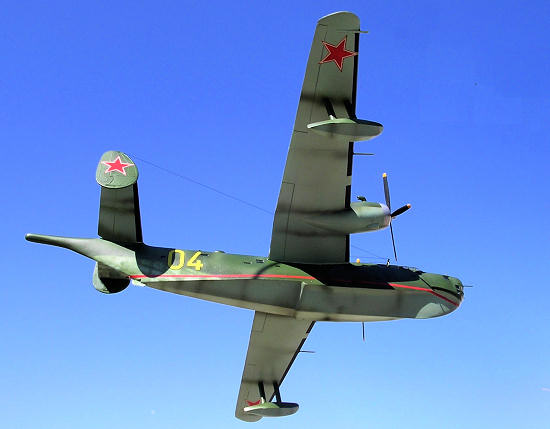 I elected to do the later version of the Be-6,
which was mounted with a Magnetic Anomaly
Detector "
I elected to do the later version of the Be-6,
which was mounted with a Magnetic Anomaly
Detector "
The transparencies supplied are in very clear
plastic. In all there are a
total of 38 components excluding the 2-part
stand, which I always discard anyway. There is
an assembly drawing which makes construction straight forward if one desires to do the
version as issued. However in my opinion the
kit was very basic and fell short of my expectations. This turned out into a project that
model-wise required a lot of work to turn it
into an accurate scale replica of the real flying boat.
Certain areas such as the cockpit has no provision
of any detail and one should not be deterred
from manufacturing a cockpit floor, bulk-head, instrument panel, a couple of seats, control
columns, control foot pedals and other de-tails
as one desires. The ailerons, which are designed to be moveable, leave an unrealistic
gap when raised or lowered so it would be best to fix these in place permanently. At the lower part of the hull there is
a rectangular slot into which the
stand will fit. This needs to be trimmed and filled.
Over the years I managed to acquire copies
of LETECTVI
+
KOSMONAUTIKA,
a Czech magazine that goes back to 1980. This contained an article, which related to updating
the Be-6 kit. Pages 290 and 291 produced a side
elevation of the fuselage and wing plans and
on pages 374 and 375 there is an accurate
"stinger"
| CONSTRUCTION |
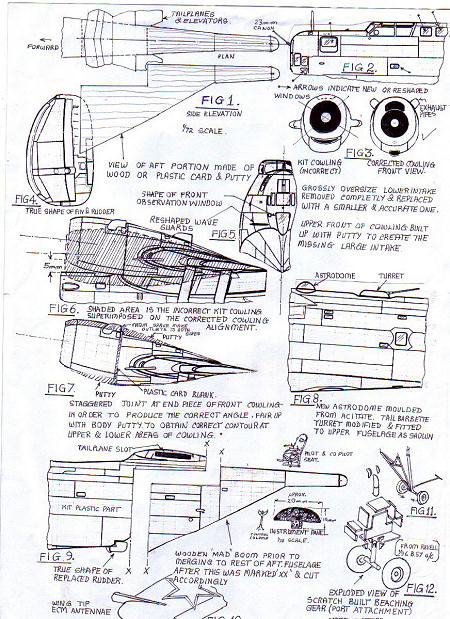 The model of my Be-6 was converted to the
later version, which involved modifying the rear
end of the fuselage to take the
The model of my Be-6 was converted to the
later version, which involved modifying the rear
end of the fuselage to take the
The next step was to place the fuselage halves, part I and 2 together, securing them temporarily with tape from three places. This
allowed marking and
cutting along line "X-X"
shown in FIG.9. This was then cut with a Xacto knife and fine saw. The horizontal part
was the tricky bit. This was scored
several times over using a sharp
modeling knife until it broke away
gently from the corresponding half
of the fuselage, one at a time. The
end bit of the kit fuselage was discarded.
A medium file brought down the desired
joint preparation so that there is an
even and corresponding joint between
the fuselage section at
"X-X" and the wooden shaped piece at
"X-X"
that contains the "
The kit first appeared on the market over 20 years ago and was then a reasonable product. With the advent of the breakdown of the Iron Curtain certain details on military aircraft started to appear in
form of photos, accurate
drawings, data, etc, certain areas on the kit
such as the portion ahead of the
cockpit, aft of the cockpit, wave guard
fairing, position of antenna masts, grossly raised panel lines, shape and size of turret/barbette
needed to be looked into and each item is rectified with careful reference
to the new material. Though small items
these appear to be, it is surprising
what improvements these will bring to the "end-product"
appearance.
While the kit is still in pieces, it is important to mark, drill and shape the 15 porthole windows that are scattered throughout the length of both fuselage sides. The
location of these is
identified with careful reference to the 1:72
scale drawing shown. Some of the existing
ones may need to be blanked over with
plastic card and replaced with others
of the correct shape and at the right
place. At this early stage the main
plane and tail plane parts are glued
together and allowed to set.
Major kit faults corrected
A major fault in the kit lies with the angle of the center line of the engine cowlings with the horizontal. A quick check with FIG.6 or reference to the 1:72 scale plan side elevation will reveal the new angle of elevations. This needs to be
so much inclined so that
when viewed from the side, the lower part of the cowling front rim is
5mm higher than the uppermost level of the
fuselage. This is illustrated clearly in FIG.6.
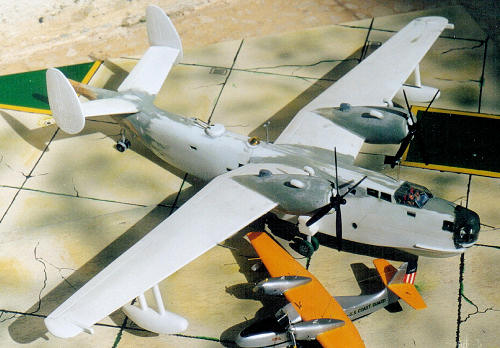 In order to reproduce this inclination to the kit parts this has to be carried out as follows:
In order to reproduce this inclination to the kit parts this has to be carried out as follows:
(A) Remove the exhaust pipes, which are wrongly placed at the cowling joint line. The huge lower intake is also filed off completely.
See FIG.3. Replacement small intake ducts and new position of exhaust pipes are needed.
(B) Blank the rear end of the cowling (parts 14 and 15) with a 25mm round plastic card.
(C) The upper edge of the cowling on wing (parts 3 and 4) are filed 2mm at the joint so that when parts 14 and 15 are fitted these have a corrected inclination.
(D) With reference to FIG.7, the cowling parts are now joined together noting the new angle of inclination and also the joint is staggered by 3.5mm at the upper and lower rim of the cowling ends.
(E) Once this has dried out, the stagger is built up with putty. This is allowed to dry, reshaped and faired over. A somewhat tedious operation but in the end it brings a satisfactory result.
FIG.7 indicated
the built up areas, which are shown in shaded lines.
(F) All along the upper area of the cowling is built up with putty to produce the upper air intake, which was non-existent in the kit.
FIG.3 shows the incorrect cowling front
as compared to the
new one. Note also the upper
area of the kit cowling that needs to be filed (shown in dotted lines) before the putty is
added. This will be the lower in-take front/wall.
(G) Having built up and reshaped the cowling, a small air intake is added
to the lower cowling front as per drawing. The air intake is made out of a rear part of a small fuel tank (2
in number) found in the spares box. (e.g. AIRFIX Fiat G91 wing tanks). The upper exhaust pipes are produced from sprue, which are shaped and hollowed out at one end.
Conversion to the
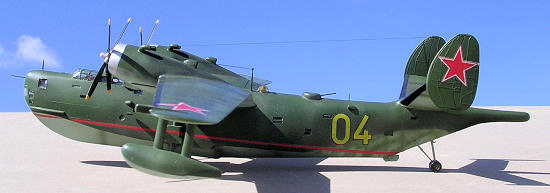 Before the two fuselage halves are permanently joined, any cockpit detail as mentioned earlier is
completed. Sketches show
shape of pilot and cockpit seat, control
86 column and instrument panel. I
added two crewmembers as it
gives a scale indication and more
life to the completed model. The
drawings show all the identifying
features of the Be-6 to convert to "
Before the two fuselage halves are permanently joined, any cockpit detail as mentioned earlier is
completed. Sketches show
shape of pilot and cockpit seat, control
86 column and instrument panel. I
added two crewmembers as it
gives a scale indication and more
life to the completed model. The
drawings show all the identifying
features of the Be-6 to convert to "
The 23mm cannons shown in FIG.2 & FIG.8 are made out of
1mm diameter surgical
steel needles, which are cut to the required
length as to leave 12mm barrel
length. Three in number are required, one for the front, and two
for the dorsal barbette.
The barbette was made out of
"part 12" after the required alteration by blanking part of the upper
slots and filing a flat top to con-form to the outline of the turret
shown in FIG.8 Sketches A and B
depicts enlarged details of the cannons. After the kit is completely assembled, with the major components put together, the various
aerial masts and small intake
scoops on the fuselage are added
and the joint lines of the rear modification components are sanded,
refilled and sanded gently until a smooth satisfactory finish is obtained.
The two supporting struts of the
floats needs thinning down their
sections when viewed from front as
per wing float scale drawing.
The hull rudder supplied is replaced with one from plastic card and correct outline and relocated aft of the hull structure as shown. FIG.5 shows the reshaped wave
deflectors/guards. This is done by
reducing the oversize ones integrally
molded on the fuselage front, and
also by thinning down
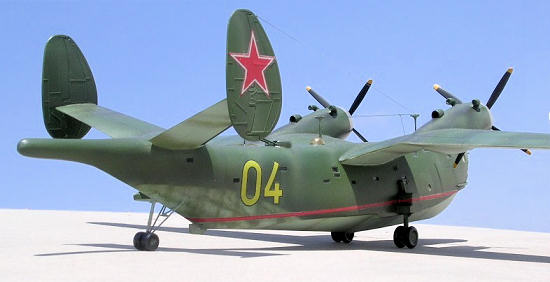 this section
with a scraper running down the remaining length. An observers front nose
window is added to conform to FIG.5 and the
scale plans. Wingtip ECM antennae are
added - see FIG. 10. These
are made from 2mm thick by 3.5mm wide plastic card, which protrudes 6mm ahead of the leading
edge.
this section
with a scraper running down the remaining length. An observers front nose
window is added to conform to FIG.5 and the
scale plans. Wingtip ECM antennae are
added - see FIG. 10. These
are made from 2mm thick by 3.5mm wide plastic card, which protrudes 6mm ahead of the leading
edge.
Having done all the extra work to improve the kit, then building up the beaching gear becomes imperative. The scale drawings show the correct size of the details to produce the beaching gear and FIG. 11 depicts an exploded view of the aft wheels construction; FIG. 71 shows the main wheel beaching gear along with parts to form the floats. These are made out of sprue and plastic card. Two wheels, 14mm diameter and 5mm wide are attached to the assembled structure on each side. The smaller rear wheels are 8.5mm diameter and 3mm wide. I found that for the main wheels, those coming from 1:96 scale REVELL B-57 Canberra kit are most suited, failing this, one can produce a single accurate wheel and cast 3 more out of resin using two part core and drag mould technique. The kit provides one leading edge aerial antenna. The location is correct but the aerial mast was discarded and replaced with one made from a pin. This is repeated to the other wing as most of the photos I have seen carried one antenna on each wing.
| COLORS & MARKINGS |
A good number of Be-6s were finished in olive green upper surfaces
and
light
blue
gray undersurfaces. On my model I applied two shades of olive
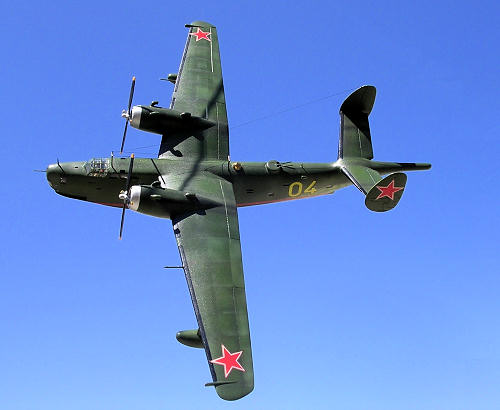 green, one lighter than the other to bring
out the weathering effect. The kit
is supplied with a reasonable quality decal sheet. These only needed
the transparent film trimmed off at
the periphery otherwise the large
red stars makes the kit look complete.
A large yellow number "04" which is
neatly outlined in thin black was
ideal for the exact version 1 have
made. A long red water line decal trim
was carefully applied to the hull.
Other weathering effect
was added by airbrushing engine gray to areas aft of the exhausts and engine-cowling front. Cowling rings were completed
in silver paint. A soft edge merging
separated the upper olive from the lower blue/gray finish.
green, one lighter than the other to bring
out the weathering effect. The kit
is supplied with a reasonable quality decal sheet. These only needed
the transparent film trimmed off at
the periphery otherwise the large
red stars makes the kit look complete.
A large yellow number "04" which is
neatly outlined in thin black was
ideal for the exact version 1 have
made. A long red water line decal trim
was carefully applied to the hull.
Other weathering effect
was added by airbrushing engine gray to areas aft of the exhausts and engine-cowling front. Cowling rings were completed
in silver paint. A soft edge merging
separated the upper olive from the lower blue/gray finish.
Alternative fuselage identification numbers carried by various types of Be-6 have been noted on photos. These include 1, 02, 07, 14, 11, 15, 10, 5, 47 and 24. Some early Be-6 and also others that went late into service were finished light gray overall. The
| CONCLUSIONS |
| REFERENCES |
Observers World Aircraft Directory - William Green
May 2010
If you would like your product reviewed fairly and quickly , please contact me or see other details in the Note to Contributors.